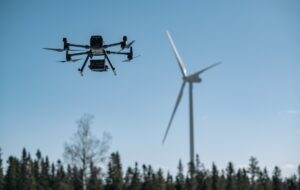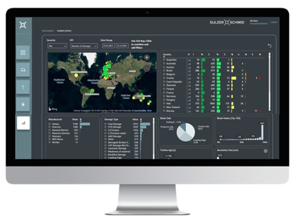Using autonomous drones to carry out a digital inspection of wind turbine rotor blades can revolutionize the inspection process, making it more efficient, reliable, and more cost effective than ever. In combination with an open and flexible software platform, this inspection method has great potential and gives you the tools to optimize both repair campaigns as well as your future O&M strategy.
By capturing high quality imagery data in a systematic manner covering the entire surface of the rotor blade, the data can be processed in a digital platform and inspected by blade experts. Damages can be identified and classified with accurate localization and size measurement, which means they can be tracked over time. Repairs can be monitored, and patterns can be analysed across inspections, for each WTG and for an entire WTG fleet. The blade platform transforms the collected images and meta-data into a mine of information.
This is fantastic technology for new wind farm installations, but where do you start if you have an aging fleet of WTG to take care of? The Sulzer Schmid 3DX™ Blade Platform can accommodate different data sources to set you on the path of fully automated digital blade inspection process, enabling you to maximize the value of your assets.
Setting your inspection objectives
 The first question that you need to consider is what you want the software to do. Inspections vary in terms of scope and requirements, and this in turn calls for a technology solution that provides a great deal of flexibility to execute different types of inspections without the need to change hardware or software.
The first question that you need to consider is what you want the software to do. Inspections vary in terms of scope and requirements, and this in turn calls for a technology solution that provides a great deal of flexibility to execute different types of inspections without the need to change hardware or software.
For example, due diligence or end-of-warranty inspections need to reveal as much detail about the blade condition as possible to accurately calculate the value of the assets. Inspection findings can have a significant impact on the wind farm selling price. Overall, inspections can be small-scale in a single location or massive, large-scale operations spread across organisations, functions, and geographies. Whilst each inspection campaign requires a unique setup, our browser-based digital platform has been designed to support all your blade inspection needs.
Supporting a global team with a collaborative platform
Today’s setup with global teams and remote working conditions puts different constraints on an organisation and requires a truly collaborative platform for data capture and data analytics. It is no longer efficient to work with large amounts of PDF reports where data cannot be filtered and compared. Likewise, searching for information in hundreds of excel sheets is time consuming and tedious.
Designed to easily integrate into the existing environments of operators, OEMs, and turbine service providers, the 3DX™ Blade Platform supports an efficient workflow and integrates every aspect of the rotor blade inspection in one place. The platform facilitates the seamless collaboration of everyone involved in the inspection process. From planning and operation to drone operators, blade experts and reviewers, the data can be used for insights, trend analysis and planning of repair campaigns. Reports are automatically generated and easily shared, and the data is accessible through customizable dashboards. There is also a ‘deep link’ feature which allows users to share secure links to inspection data with teams, partners, and customers.

Using data from the past to understand the present and project the future
Another important consideration is the integration of historical data into the blade inspection platform. Historical data provides an important starting point for tracking the evolution of rotor blade damages and repairs. Intelligent analysis of the data can provide valuable insights into failure rates and damage propagation. Historically, however, blade inspections have not been carried out with statistical analysis in mind. A cost/benefit analysis must inform the decision to incorporate this data within a modern digital inspection platform, as the cost depends very much on the data format. For archives consisting of pdf only documents, this process can be expensive and difficult to justify. However, if rope or ground inspection results have been captured in a digital format (Excel, Database etc.) then the data can be processed and imported into a unified platform using customizable data adaptors. Hence, if you are using an open platform technology such as 3DX™, all digital data sources can be imported and analysed, ensuring you build up a lifetime record of your assets.
Complying with different taxonomy standards and ensuring compatibility with customized data specifications
The digital format of drone inspections means that they are perfectly suitable to be processed in a blade inspection platform. However, the lack of industry standards regarding meta data and damage classification (taxonomy) means that customized data adaptors are often required to process and upload the data into the platform. At Sulzer Schmid we have overcome this obstacle. Our platform supports a broad range of customer-specific conventions meaning that the classification system matches that of our customers.
The importance of research
Drone inspections are growing rapidly and have received wide industry acceptance. The UAV is the perfect tool to carry a camera close to the surface of the rotor blade to visually record images of the entire blade surface. They are suitable for all turbine sizes, and capable of delivering cost-effective high-quality images. By conducting several flight paths, (most commonly LE, TE, PS, SS) along the blade at different observation angles they provide full coverage of the blade.
Understanding your needs today and your objectives for the future will define which technology and platform configuration is right for you. It pays off to do some research and talk to an experienced technology provider who can guide you through the process and answer all the questions you have. Contact Marc Hoffmann or book a demo with us today if you are interested in finding out more about digital rotor blade inspections in general and the 3DX™ Blade Platform in particular.
Marc Hoffmann
Global Head of Sales and Marketing
marc.hoffmann@sulzerschmid.ch
+49 173 277 82 81